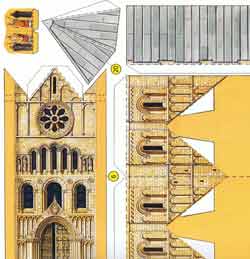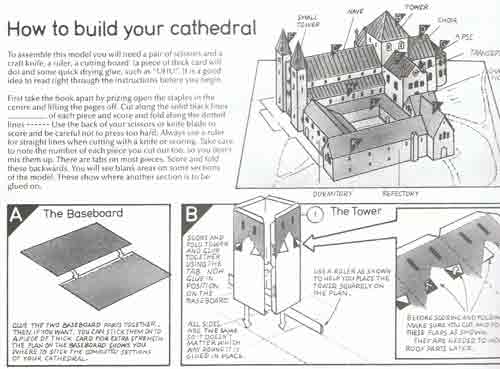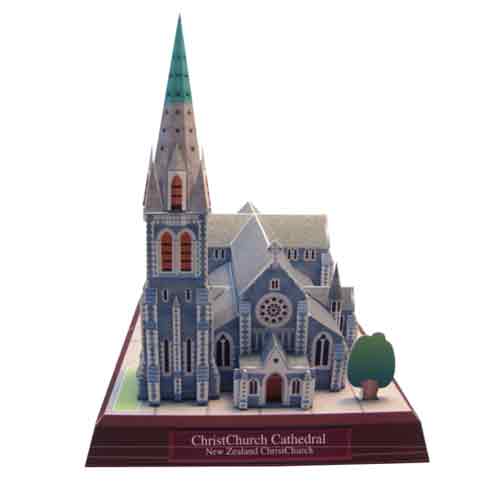Christchurch’s transitional cathedral group had hoped for a decision a fortnight ago about the location of the $4 million Christchurch cardboard cathedral. Maybe some more lateral thinking is happening…
Speaking of lateral thinking: at the recent Whitcoulls bookshop sale, I purchased a cardboard cathedral for $7 (images).
The costly Christchurch cardboard cathedral (CCCC) is designed by Shigeru Ban. You can see more interesting different designs of his here and here.
Christchurch architects follow the I-can-draw-rectangles style of architecture, and Shigeru Ban has followed that style to fit in with that. For the CCCC he has ingeniously joined two rectangles together, so also holding the memory of the quake-damaged neo-gothic cathedral as well as echoing a wharenui (Maori meeting house).
Over its projected decade of use, $4million works out at $8,000 a week. To work that out per person per week, let’s round the congregation to … well, you can do the maths…
If you are putting money on it, here’s a tip: the CCCC (although the worse for wear) will still be here after a decade. There is nothing as permanent as a temporary measure in this country. Witness the following Anglican cathedrals where temporary became permanent: Auckland, Nelson, Dunedin, and – yes, even the Christchurch cathedral in the Square was only 6/7th completed when the quakes hit. [Don’t get the impression that unrealism in what, from a pretty plan, will ultimately be built is merely an ecclesiastical kiwi phenomenon or I’ll start with our NZ parliament building for the next list: is our parliament building 1/4 or 1/8th completed according to the pretty plan? I forget.]
 My proposal, the $7 version (cCCC, cheap cardboard Christchurch Cathedral), comes complete with cardboard clergy – a money-saving bonus, as the current dean has just resigned. Cardboard children can be added. This is a boon for Anglicans who are always looking for ways to bring the age of congregations down – without actually dealing with real children and young people who tend to wriggle, make noise, disturb, and generally ask difficult questions. Should Anglican church attendance continue to drop, I’m sure that cardboard congregation members can increasingly be added without any significant loss (see model).
My proposal, the $7 version (cCCC, cheap cardboard Christchurch Cathedral), comes complete with cardboard clergy – a money-saving bonus, as the current dean has just resigned. Cardboard children can be added. This is a boon for Anglicans who are always looking for ways to bring the age of congregations down – without actually dealing with real children and young people who tend to wriggle, make noise, disturb, and generally ask difficult questions. Should Anglican church attendance continue to drop, I’m sure that cardboard congregation members can increasingly be added without any significant loss (see model).
The further advantage of my cCCC proposal is that a cardboard city is available that can be added to the project.
Literalists (yes, there are even literalistic Anglicans now!) please check the tags to this post.
ps. For some more serious lateral thinking, the suggestion of an ecumenical cathedral is not uncommon. As the dust of the quakes has begun to settle, the iconic nature of the cathedral in the Square has become clearer. Many do not think of the cathedral as being secterianly “Anglican” (eg. secular schools have had Christmas events there in a way they would never countenance in any other church building). The church’s use of the word “rebuild” has often been heard as “replicate”. Many would not understand the intricacies of the difference, eg., between a bishop and a dean – including within the church, nor the decision-making processes now underway (re. new dean, temporary cathedral, what to do in the Square). Many would not realise that “Christ Church” is the cathedral’s title (just as it is the title of Nelson’s cathedral). There are other options one hears, including gifting the building etc. to the city and province while Anglicanism has kaitiakitanga (including providing a dean, etc.). There is much to consider consultatively and prayerfully.
UPDATE 24 January
Claudia, a regular participant here, provided a link to a site where you can download a cardboard cathedral. It’s the cathedral we had (see image below)! And it’s… FREE! So: download; enlarge to required size; print onto good Shigeru-Ban-quality cardboard; and place on a site of your choice! (You can even move it about).






I would like an ecumenical cathedral for Christchurch to be considered. It would be a missionally and theologically good thing to work on. As suggested to me recently, it could be two cathedrals side by side or (my preference) a single edifice with twin spaces, one for the Catholics and one for the Anglicans [or any other combo able to put up some decent money] … the latter (at least) would be open to use by other churches … and folding doors between could open up the whole for some services, including my funeral :). Of course the space for that size building doesn’t exist in Cathedral Square but I have my eye on some other land …
Peter, as well as your lateral thinking (to which, you possibly noticed, I linked in the original post), your positive assurance, that congregations in the future will be so large that space in Cathedral Square could not hold them, is scarily inspiring. Blessings.
I can’t see why the cardboard cathedral shouldn’t be thought of as a permanent fix to start off with! I find the idea of spending *more* than $4 million on a building appalling, whatever the Canterbury Aristocracy might think.
^disclaimer: not from Canterbury!
Thanks, Chris (and for the acknowledgement of the disclaimer). I’m not sure that more than $4million is actually that unusual for a significant building – to be fair. Nor am I at all privy to the insurance issues – some insurance funds, as I understand it, are tied to actually being used for a replacement building. Lateral thinking, like yours, I would like to stress, needs to be part of the mix. Blessings.
Here’s a paper cathedral you can print out an build yourself – and it look remarkably familiar too! 😉
http://cp.c-ij.com/en/contents/3152/christchurch/index.html
What an amazing find, Claudia! [I do notice everything is in the present rather than the past tense!] I might have to update the actual post to include this. Brilliant! Thank you! What if we enlarge this onto good, strong cardboard – all our problems may be solved! Blessings.
Given the original Cathedral took some 40 years to build, do you think a decade for the temporary structure might be a tad optimistic?
On a more serious note, in my opinion what made the Cathedral special was not *just* the architecture, but the spiritual sacredness of the place, the fact that generations had worshipped and prayed there was what made it Holy Ground, and a ceremony of de-consecration does not take away that sacredness. I think a modern building can still express the same “feel” as the original building without needing to be an exact replica, but the place for that structure to be built is where it has always been: in the heart of the city.
It seems to me that the logical place for the Cardboard Cathedral is in Cathedral Square itself…either directly oopposite the damaged Cathedral or 90 degrees to it to the South. The Red Zone won’t last forever, and that keeps the Cathedral at the heart of the City.
By the way, there are ways of repairing /restoring the Cathedral that do not include wholesale demolition. Without having to demolish and rebuild wholesale saves the church, and tens of millions of dollars. In short, you could have your Cathedral back much the way it was and strong enough to last for Centuries at a cost equal to or less than they project for a new Cathedral. If you are interested, I’ll explain how that would work.
In the mean time, just to demonstrate that I’ve been thinking hard about things Chch, check out my proposal to rebuild the Steeple. Do download the text from the web site. In particular read the bit about the Theology. The point is to use the building of the Steeple as a vehicle for rebuilding the Community. To raise the Spire into place would require 500 Cantabrians manning Capstans out in Cathedral Square. The future of the City, literally in their hands.
Have a look: http://www.thePeoplesSteeple.org
Thanks, Marcus. I have seen your proposal receiving good attention. It is good when different ideas are thought through. I like the image of a community being formed through together raising a barn. That can be applied in so many ways. Blessings.
Peter, do you have a date in mind for the funeral? Given a long friendship and working relationship – we even agree with each other sometimes – that is an event I would feel privileged to attend.
On a more serious note, and regarding kaitiakitanga and similar concepts, I wonder if the example of the National Cathedral in Washington DC might be helpful. It is definitely an Episcopal(ian) institution, but it promotes itself as:
“…a spiritual resource for our nation: a great and beautiful edifice in the city of Washington, an indispensable ministry for people of all faiths and perspectives, and a sacred place for our country in times of celebration, crisis, and sorrow”. Not a bad mission for a cathedral.
I think that sort of vision could well be served by Peter’s (and others) idea of an Ecumenical Cathedral, with distinct spaces that can be opened into one when appropriate. The details would be a headache, but I don’t think the principle would be that difficult to sell to the Anglican Church. I am not so sure about the Catholics though. Do you, Peter, or Bosco, have any evidence that they would be open to such a vision?
Thanks, Edward. I also have had the National Cathedral in Washington in mind, and made some contacts to clarify how that all worked. In the end I thought we could consider a more indigenous, contextualised model – though that example shows some of what I mean. Ownership in that situation is definitely by TEC. Blessings.
I truly love the notion of an Ecumenical Cathedral sensitive to all the stakeholders in Chch. That is very much what the Cathedral has become. Brilliant idea, Peter.
It is interesting that you bring up the National Cathedral in Washington, DC. One of my colleagues, Patrick Plunkett, was the lead mason on the final phases of the construction of that Cathedral. He also taught Cathedral restoration to young masons at Salisbury Cathedral before taking the post in DC.
Over New Years, he and I poured over the drawings and photographs of the damage to the Cathedral. After many cups of tea and much beard stroking, Patrick declared that Christchurch Cathedral was absolutly repairable without the extensive demolition currently planned. He’s willing to come to NZ and discuss this.
I originally approached him as part of the Stone Carvers Guild. It occured to me that they might be willing to offer to replicate the Rose Window as a donation in-kind, much as the Timberframer’s Guild (US and Canada) and UK Carpenter’s Fellowship have offered to donate the carpentry for the Steeple.
Patrick thought that replication would be unnecessary, as his experience suggests that much, if not most, of the original might be in repairable condition.
Technically, restoring the Cathedral is pretty straight forward. The Politically… THAT is where it gets difficult.
As always, I hold you all in the Light,
Marcus Brandt
Hello Edward and others,
I am planning to live till 100 so that gives the Christians of Christchurch till 2059 to get things sorted out! I think that is a reasonable lead time … of course by then there might only be a few younger family members and no contemporaries left to give thanks that I have finally ceased to be a burden to them 🙂
I do not think one needs to talk to local Catholics to recognise that the ecclesiology of Catholicism makes it extremely unlikely that anything less than a separate sovereign space available to be the Catholic cathedral would be unsatisfactory both to the local bishop and to Rome. I also think there is not much point in talking to local Catholics about a side-by-side (with potential for shared space on special occasions) edifices until we Anglicans had come to our own conviction about that. Cutting a long story short, our current conversation is heading in a different direction: my proposal, effectively, is looking ahead to a possible way forward if the current conversation came to an end.
As for the Washington National Cathedral: it has its own current troubles so I would be studying it carefully re its viability as a model for NZ; but either way, it is not a side-by-side space which allows Catholics sovereignty over there own space.
As for restoration of our cathedral via local and international stonemasons: maybe. But everything (i.e. hints, half-remarks, reading between the lines of newspaper reports) I hear implies to the amateur engineer within me that we are talking about a rebuild from the ground up if we seek to restore what once was. Is that what we Anglicans and non-Anglicans of Christchurch/Canterbury want to see happen?